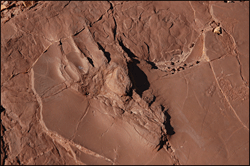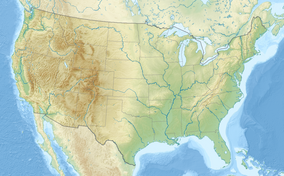Prehistoric Trackways National Monument
| Prehistoric Trackways National Monument | |
|---|---|
|
IUCN category V (protected landscape/seascape)
|
|
 |
|
|
Location of Prehistoric Trackways National Monument within the United States
|
|
| Location | Doña Ana County, NM, USA |
| Nearest city | Las Cruces, New Mexico |
| Coordinates | 32°21′0″N 106°54′0″W / 32.35000°N 106.90000°WCoordinates: 32°21′0″N 106°54′0″W / 32.35000°N 106.90000°W |
| Area | 5,255 acres (2,127 ha) |
| Established | March 30, 2009 |
| Governing body | Bureau of Land Management |
| Website | Prehistoric Trackways National Monument |
Prehistoric Trackways National Monument is a national monument in the Robledo Mountains of Doña Ana County, New Mexico, United States, near the city of Las Cruces. The monument's Paleozoic Era fossils are on 5,255 acres (2,127 ha) of land administered by the Bureau of Land Management. It became the 100th active U.S. national monument when it was designated on March 30, 2009.
The Prehistoric Trackways National Monument site includes a major deposit of Paleozoic Era fossilized footprints in fossil mega-trackways of land animals, sea creatures, and insects. These are known as trace fossils or ichnofossils. There are also fossilized plants and petrified wood present, as well as plenty of marine invertebrate fossils including brachiopods, gastropods, cephalopods, bivalves, and echinoderms. Much of the fossilized material originated during the Permian Period and is around 280 million years old.
Some of the animals who may have left tracks in the Robledo Mountains include Dimetrodon, Eryops, Edaphosaurus, and multiple other pelycosaurs. There are at least 13 major trace fossils found at the monument, including Selenichnites (sel-EEN-ick-NIGHT eez) or moon-shaped trace, Kouphichnium (koof-ICK-nee-um) or light trace, Palmichnium (pal-ICK-nee-um) or palm [frond] trace, Octopodichnus (oct-toe-pod-ICK-nuss) or eight-footed trace, Lithographus (lith-oh-GRAFF-us) or rock writing, Tonanoxichnus (tong-a-nox-ICK-nuss) or Tonganoxie [Kansas] trace, Augerinoichnus (aw-gurr-EE-no-ICK-nuss) or Augerino trace, Undichna (und-ICK-nuh) or wave-shaped trace, Serpentichnus (serpent-ICK-nuss) or snake-like trace, Batrachichnus (baa-track ICK-nuss) or frog trace, Dromopus (dro-MOE-puss) or running foot, and Dimetropus (die-MEET-row-puss) or Dimetrodon foot.
...
Wikipedia

